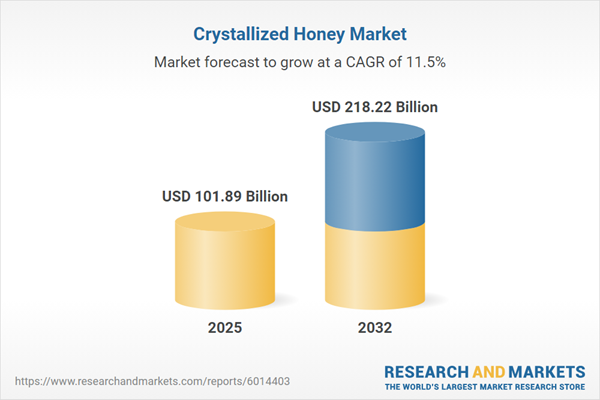Speak directly to the analyst to clarify any post sales queries you may have.
Crystallized honey is emerging as a strategic ingredient in the global B2B landscape, powering innovation across food manufacturing, health, and consumer goods sectors as organizations advance their focus on transparency, traceability, and regulatory compliance.
Market Snapshot: Crystallized Honey Market Size and Emerging Opportunities
The global crystallized honey market is entering a strong growth phase, with sales estimated at USD 91.15 billion in 2024 and a projected increase to USD 218.22 billion by 2032. The changing preference for natural sweeteners and responsible sourcing practices is driving expansion, as businesses address rising consumer demand for clean-label ingredients. Advanced crystallization processes are enabling product differentiation, while traceability remains key in supplier selection as regulations intensify. Both established brands and new entrants are responding to these dynamics, using innovation to address opportunities in mature and developing markets alike.
Scope & Segmentation: Strategic Insights for Enterprise Buyers
This report delivers a comprehensive overview of the crystallized honey market, providing segment-level intelligence to support procurement, new product planning, and supply optimization initiatives:
- Distribution Channels: Assess the influence of convenience stores, digital retail, specialty wholesale, supermarkets, and hypermarkets on B2B outreach, and adjust supply chain models to maximize reach and efficiency.
- Online Retail Sub-Channels: Explore procurement through brand websites, desktop and mobile e-commerce, and third-party B2B marketplaces to identify key digital transformation opportunities.
- Packaging Types: Compare bottles, jars, squeeze tubes, and stick packs regarding portion control, transit efficiency, and suitability for private labeling projects.
- Floral Sources: Examine buckwheat, clover, manuka, and multifloral options for their applications across food, wellness, and industrial segments, focusing on attributes valued by business buyers.
- Product Grades: Distinguish between organic and conventional crystallized honey as part of sustainability and compliance strategies.
- Applications: Identify integration opportunities in food and beverage production, personal care, and pharmaceuticals, highlighting functional versatility for large-scale operations.
- Regional Coverage: Consider trends and regulatory differences across the Americas, Europe, Middle East & Africa, and Asia-Pacific to inform sourcing and innovation.
- Leading Companies: Benchmark offerings and strategies from industry leaders, including Dabur India Limited, Capilano Honey Limited, Comvita Limited, Rowse Foods Limited, Dutch Gold Honey, Nature Nate’s Honey Company, Y.S. Eco Bee Farms, Simpson & Vail, Barkman Honey, and Billy Bee Foods, to address varied buyer requirements.
This segmentation enables senior leaders to structure procurement processes, oversee digital integration, and align ingredient verification across the entire crystallized honey supply network.
Key Takeaways for Senior Decision-Makers
- Specialty sweeteners are supporting product development tailored to distinct regional market requirements and evolving standards.
- Automation and advanced process control in crystallization offer improvements in consistency and operational efficiency throughout sourcing and distribution.
- Modern traceability protocols support compliance and enhance business resilience, building confidence among institutional buyers in B2B environments.
- Digital procurement tools streamline supplier evaluation and sourcing, enabling buyers to rapidly respond to demand shifts and ingredient customization needs.
- Adaptable packaging formats contribute to enhanced logistics management and flexible tracking, supporting compliance with dynamic distribution models and shifting regulations.
Tariff Impact on Sourcing & Procurement
Recent tariffs affecting raw and semi-processed honey in North America are prompting organizations to reassess sourcing strategies, supply costs, and lead times. In response, enterprises are investing in domestic processing capabilities and widening supplier networks. Enhanced supplier qualification and robust quality assurance protocols are helping to reinforce supply chain stability as trade policies evolve.
Methodology & Data Sources
This analysis is grounded in a triangulated methodology spanning executive interviews, extensive field research, and review of industry, regulatory, and patent records. Ongoing peer engagement and data verification assure findings are both trusted and relevant for strategic planning.
Crystallized Honey: Why This Report Matters
- Delivers actionable insights at the segment level, including supplier benchmarking and technology adoption, to support decisive procurement and executive leadership.
- Clarifies regulatory updates, supply chain trends, and primary market drivers, aiding strategy development and interdepartmental alignment.
- Identifies regional and application-based opportunities, bolstering long-term growth and fostering collaboration among sector stakeholders.
Conclusion
Organizations focusing on traceable sourcing and customized product innovation are best positioned to capture sustainable growth and navigate compliance demands as the crystallized honey market evolves.
Additional Product Information:
- Purchase of this report includes 1 year online access with quarterly updates.
- This report can be updated on request. Please contact our Customer Experience team using the Ask a Question widget on our website.
Table of Contents
3. Executive Summary
4. Market Overview
7. Cumulative Impact of Artificial Intelligence 2025
Companies Mentioned
The companies profiled in this Crystallized Honey market report include:- Dabur India Limited
- Capilano Honey Limited
- Comvita Limited
- Rowse Foods Limited
- Dutch Gold Honey, Inc.
- Nature Nate's Honey Company, LLC
- Y.S. Eco Bee Farms, Inc.
- Simpson & Vail, Co.
- Barkman Honey, LLC
- Billy Bee Foods LP
Table Information
| Report Attribute | Details |
|---|---|
| No. of Pages | 185 |
| Published | November 2025 |
| Forecast Period | 2025 - 2032 |
| Estimated Market Value ( USD | $ 101.89 Billion |
| Forecasted Market Value ( USD | $ 218.22 Billion |
| Compound Annual Growth Rate | 11.5% |
| Regions Covered | Global |
| No. of Companies Mentioned | 11 |









